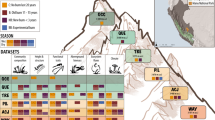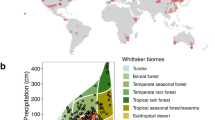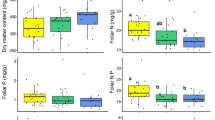Abstract
Leaf traits are frequently measured in ecology to provide a ‘common currency’ for predicting how anthropogenic pressures impact ecosystem function. Here, we test whether leaf traits consistently respond to experimental treatments across 27 globally distributed grassland sites across 4 continents. We find that specific leaf area (leaf area per unit mass)—a commonly measured morphological trait inferring shifts between plant growth strategies—did not respond to up to four years of soil nutrient additions. Leaf nitrogen, phosphorus and potassium concentrations increased in response to the addition of each respective soil nutrient. We found few significant changes in leaf traits when vertebrate herbivores were excluded in the short-term. SLA, and leaf nitrogen and potassium concentrations were positively correlated with species turnover, suggesting interspecific trait variation was a significant predictor of these traits, but not of leaf phosphorus concentration. Climatic conditions and pretreatment soil nutrient levels also accounted for significant amounts of variation in the leaf traits measured. Overall, we find that leaf morphological traits, such as specific leaf area, are not appropriate indicators of plant response to anthropogenic perturbations in grasslands.
This is a preview of subscription content, access via your institution
Access options
Access Nature and 54 other Nature Portfolio journals
Get Nature+, our best-value online-access subscription
$29.99 / 30 days
cancel any time
Subscribe to this journal
Receive 12 digital issues and online access to articles
$119.00 per year
only $9.92 per issue
Buy this article
- Purchase on Springer Link
- Instant access to full article PDF
Prices may be subject to local taxes which are calculated during checkout




Similar content being viewed by others
Data availability
The data that support the findings of this study are available in the Dryad Digital Repository with the identifier https://doi.org/10.5061/dryad.qp25093.
Change history
15 May 2020
An amendment to this paper has been published and can be accessed via a link at the top of the paper.
References
Rockstrom, J. et al. A safe operating space for humanity. Nature 461, 472–475 (2009).
Ripple, W. J. et al. Collapse of the world’s largest herbivores. Sci. Adv. 1, e1400103 (2015).
Estes, J. A. et al. Trophic downgrading of plant earth. Science 333, 301–306 (2011).
Borer, E. T. et al. Herbivores and nutrients control grassland plant diversity via light limitation. Nature 508, 517–520 (2014).
McIntyre, S. The role of plant leaf attributes in linking land use to ecosystem function in temperate grassy vegetation. Agric. Ecosyst. Environ. 128, 251–258 (2008).
Funk, J. L. et al. Revisiting the Holy Grail: using plant functional traits to understand ecological processes. Biol. Rev. 1153–1176, 1–18 (2017).
Shipley, B., Vile, D. & Garnier, E. From plant traits to plant communities: a statistical mechanistic approach to biodiversity. Science 314, 812–814 (2006).
Messier, J., McGill, B. J. & Lechowicz, M. J. How do traits vary across ecological scales? A case for trait-based ecology. Ecol. Lett. 13, 838–848 (2010).
Hooper, D. U. et al. Effects of biodiversity on ecosystem functioning: a consensus of current knowledge. Ecol. Monogr. 75, 3–35 (2005).
Lavorel, S. & Garnier, E. Predicting changes in community composition and ecosystem functioning from plant traits: revisiting the Holy Grail. Funct. Ecol. 16, 545–556 (2002).
Firn, J., Schuetz, M., Nguyen, H. & Risch, A. C. Herbivores sculpt leaf traits differently in grasslands depending on life form and land-use histories. Ecology 98, 239–252 (2017).
Suding, K. N. et al. Scaling environmental change through the community-level: a trait-based response-and-effect framework for plants. Glob. Change Biol. 14, 1125–1140 (2008).
Wright, I. J. et al. Assessing the generality of global leaf trait relationships. New Phytol. 166, 485–496 (2005).
Wright, I. J. et al. The worldwide leaf economics spectrum. Nature 428, 821–827 (2004).
Westoby, M. & Wright, I. J. Land-plant ecology on the basis of functional traits. Trends Ecol. Evol. 21, 261–268 (2006).
Diaz, S. et al. The plant traits that drive ecosystems: evidence from three continents. J. Veg. Sci. 15, 295–304 (2004).
Garnier, E. et al. Assessing the effects of land-use change on plant traits, communities and ecosystem functioning in grasslands: a standardized methodology and lessons from an application to 11 European sites. Ann. Bot. (Lond.) 99, 967–985 (2007).
Jarrell, W. M. & Beverly, R. B. The dilution effect in plant nutrition studies. Adv. Agron. 34, 197–224 (1981).
Dwyer, J. M., Hobbs, R. J. & Mayfield, M. M. Specific leaf area response to environmental gradients through space and time. Ecology 95, 399–410 (2014).
Leishman, M. R., Haslehurst, T., Ares, A. & Baruch, Z. Leaf trait relationships of native and invasive plants: community- and global-scale comparisons. New Phytol. 176, 635–643 (2007).
Grace, J. B. et al. Guidelines for a graph-theoretic implementation of structural equation modeling. Ecosphere 3, 1–44 (2012).
Grace, J. B. et al. Integrative modelling reveals mechanisms linking productivity and plant species richness. Nature 529, 390–393 (2016).
Borer, E. T. et al. Finding generality in ecology: a model for globally distributed experiments. Methods Ecol. Evol. 5, 65–73 (2014).
Cornelissen, J. H. C. et al. A handbook of protocols for standardised and easy measurement of plant functional traits worldwide. Aust. J. Bot. 51, 335–380 (2003).
Rue, H., Martino, S. & Chopin, N. Approximate Bayesian inference for latent Gaussian models by using integrated nested Laplace approximations. J. R. Stat. Soc. B 71, 319–392 (2009).
Elser, J. J. et al. Global analysis of nitrogen and phosphorus limitation of primary producers in freshwater, marine and terrestrial ecosystems. Ecol. Lett. 10, 1135–1142 (2007).
Peeter, P. J. Correlations between leaf structural traits and the densities of herbivorous insect guilds. Biol. J. Linn. Soc. 77, 43–65 (2002).
Borer, E. T., Grace, J. B., Harpole, W. S., MacDougall, A. S. & Seabloom, E. W. A decade of insights into grassland ecosystem responses to global environmental change. Nat. Ecol. Evol. 1, 0118 (2017).
Fay, P. A. et al. Grassland productivity limited by multiple nutrients. Nat. Plants 1, 15080 (2015).
Galloway, J. N. et al. The nitrogen cascade. Bioscience 53, 341–356 (2003).
Lynch, J. P. & Brown, K. M. Topsoil foraging—an architectural adaptation of plants to low phosphorus availability. Plant Soil 237, 225–237 (2001).
Siefert, A. et al. A global meta-analysis of the relative extent of intraspecific trait variation in plant communities. Ecol. Lett. 18, 1406–1419 (2015).
Albert, C. H. et al. Intraspecific functional variability: extent, structure and sources of variation. J. Ecol. 98, 604–613 (2010).
Cingolani, A. M., Posse, G. & Collantes, M. B. Plant functional traits, herbivore selectivity and response to sheep grazing in Patagonian steppe grasslands. J. Appl. Ecol. 42, 50–59 (2005).
Firn, J., Prober, S. M. & Buckley, Y. M. Plastic traits of an exotic grass contribute to its abundance but are not always favourable. PLoS ONE 7, e35870 (2012).
Dorrough, J., Ash, J. & McIntyre, S. Plant responses to livestock grazing frequency in an Australian temperate grassland. Ecography 27, 798–810 (2004).
Whalley, R. D. B. Grassland regeneration and reconstruction: the role of grazing animals. Ecol. Manag. Restor. 6, 3–4 (2005).
Lind, E. M., Myron, E. P., Giaccai, J. & Parker, J. D. White-tailed deer alters specialist and generalist insect herbivory through plant traits. Environ. Entomol. 41, 1409–1416 (2012).
Daubenmire, R. A canopy-coverage method of vegetation analysis. Northwest Sci. 33, 43–64 (1959).
Abramoff, M. D., Magalhaes, P. J. & Ram, S. J. Image processing with ImageJ. Biophotonics Int. 11, 36–42 (2004).
Duodu, G. O., Goonetilleke, A., Allen, C. & Ayoko, G. Determination of refractive and volatile elements in sediment using laser ablation inductively coupled plasma mass spectrometry. Anal. Chim. Acta 898, 19–27 (2015).
USA National Institute of Standards and Technology (Gaithersburg, MD 20899, 2017). Standard reference material 1547 peach leaves, https://www.nist.gov/?srm=1547
USA National Institute of Standards and Technology (Gaithersburg, MD 20899, 2014). Standard reference material 1570a trace elements in spinach leaves, https://www.nist.gov/?srm=1547
Longerich, H. P., Jackson, S. E. & Gunther, D. Laser ablation inductively coupled plasma mass spectrometric transient signal data acquisition and analyte concentration calculation. J. Anal. Atom. Spectrom. 11, 899–904 (1996).
Paton, C. et al. Improved laser ablation U-Pb zircon geochronology through robust downhole fractionation correction. Geochem. Geophys. Geosyst. 11, Q0AA06 (2010).
R Development Core Team R: A Language and Environment for Statistical Computing (R Foundation for Statistical Computing, 2013).
Dawid, A. P. Statistical theory: the prequential approach. J. R. Stat. Soc. A 147, 278–292 (1984).
Czado, C., Gneiting, T. & Held, L. Predictive model assessment for count data. Biometrics 65, 1254–1261 (2009).
Rosseel, Y. lavaan: an R package for structural equation modelling. J. Stat. Softw. 48, 1–36 (2012).
Burnham, K. P. & Anderson, D. R. Model Selection and Multimodel Inference: A Practical Information-Theoretic 2nd edn (Springer, New York, 2002).
Acknowledgements
This work was conducted using data from the NutNet collaborative experiment, funded at the site scale by individual researchers, and coordinated through Research Coordination Network funding from NSF to E.B. and E.S. (NSF-DEB-1042132). We thank the Minnesota Supercomputer Institute for hosting project data and the Institute on the Environment for hosting the network meetings. This manuscript is an outcome of a workshop kindly supported by sDiv, the Synthesis Centre of the German Centre for Integrative Biodiversity Research Halle-Jena-Leipzig (DFG FZT 118). M.N.B. and C.N. acknowledge funding from the Portuguese Foundation for Science and Technology through principal investigator contract IF/01171/2014 and PhD fellowship SFRH/BD/88650/2012, respectively. Figures 1–4 and Supplementary Fig. 5 were created by Evidently So (http://evidentlyso.com.au/). The authors thank QUT’s Central Analytical Facilities (CARF), part of the Institute of Future Environment (IFE), for use of their facilities to analyse leaf nutrient concentrations.
Author information
Authors and Affiliations
Contributions
A.C.R., E.H., J.F., M.Sc., S.M.P. and Y.M.B. developed and framed the research question(s). E.H., H.F., J.F. and J.M. analysed the data. A.C.R., A.M.M., C.A., E.L., E.P. K.H.M. and M.Sc. contributed to the data analysis. J.F. wrote the manuscript with contributions from all other authors. A.C.R., A.E., A.M.M., A.R.K., C.A.A., C.J.S., C.N., C.R., C.S.B., E.B., E.C., E.S., J.D.B., J.F., J.L.M., J.W., J.W.M., K.J.L.P., L.B., L.S., M.C.C., M.N.B., M.Sc., M.Sm., N.E., N.H., P.A.F., P.B.A., P.D.W., P.L.P., R.M., S.M.P., W.S.H., Y.H. and Y.M.B. are site coordinators. E.S., E.B., M.Sm. and W.S.H. are Nutrient Network coordinators.
Corresponding author
Ethics declarations
Competing interests
The authors declare no competing interests.
Additional information
Publisher’s note Springer Nature remains neutral with regard to jurisdictional claims in published maps and institutional affiliations.
Supplementary information
Supplementary Information
Supplementary Figs. 1–5, Supplementary Tables 1–3, Supplementary Methods and Supplementary References
Rights and permissions
About this article
Cite this article
Firn, J., McGree, J.M., Harvey, E. et al. Leaf nutrients, not specific leaf area, are consistent indicators of elevated nutrient inputs. Nat Ecol Evol 3, 400–406 (2019). https://doi.org/10.1038/s41559-018-0790-1
Received:
Accepted:
Published:
Issue Date:
DOI: https://doi.org/10.1038/s41559-018-0790-1
This article is cited by
-
Divergent growth and responses of conifer and broad-leaved trees to warming-drying climate in a semi-arid region, northern China
European Journal of Forest Research (2024)
-
Globally consistent response of plant microbiome diversity across hosts and continents to soil nutrients and herbivores
Nature Communications (2023)
-
Assessing community assembly controls over community-scale nutrient resorption responses to nitrogen deposition
Oecologia (2023)
-
The synergistic response of primary production in grasslands to combined nitrogen and phosphorus addition is caused by increased nutrient uptake and retention
Plant and Soil (2023)
-
Multidimensional responses of grassland stability to eutrophication
Nature Communications (2023)



